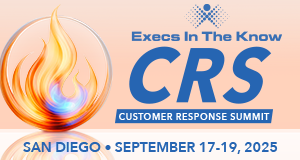
The following is a guest post from Susan Hash, editor of Contact Center Pipeline.
How much time has your executive team spent on the contact center floor? Not simply a quick walk-through, but actually taking the time to plug in with an agent to listen to customer calls? If execs really want to know what a quality customer experience sounds and feels like, spending time in the contact center will allow them to experience what your customers are feeling and thinking about your organization, as well as what frontline customer service staff go through on a daily basis.
In addition to senior executives, encouraging department leaders across the organization to spend time in the center is a great way to provide them with first-hand knowledge of what goes on within this critical touchpoint on the customer journey—and often the only interface a customer will have with an organization.
Some customer-centric organizations make it an essential activity for new leaders. At ING Direct, department leaders spend a month in the contact center jacking in with agents and listening to calls—and even handling customer complaints. They not only develop a better understanding of the frontline agent’s job, they realize how their own processes impact the contact center, and ultimately, the customer experience.
It doesn’t need to be a month-long commitment to have an effect. The contact center leadership team at Unilever found that a well-planned open house could make a significant impact. Various brand teams were invited into the center for an afternoon. The teams were given an overview of the types of information the center collected and how the frontline agents interacted with callers. Each brand team was asked to discuss the new products being released with the frontline agents so that they could offer their suggestions and ideas (an incredibly valuable resource!).
After the open house, contact center leadership followed up with the various departments to reinforce the idea that the center was willing and able to do more to support each area in improving their performance through customized reports and customer data.
Encourage the Entire Organization to Walk in the Customer’s Shoes
At BlueCross BlueShield of South Carolina, the Customer Experience team created a very unique activity designed to help non-customer-facing functions develop a better understanding of the customer service advocate’s role, and to understand how what they do impacts what happens in the contact center. They set up a call-listening room next to the employee cafeteria.
Customer Experience staff stood outside the room encouraging employees to come in and listen for at least five minutes. Once inside, employees were given popcorn and a free set of BlueCross earbuds. They watched a slide presentation that provided compelling call statistics, and then plugged in to listen to five actual customer calls, which were scrubbed of personal information.
Calls were selected that demonstrated the importance of other functions. For instance, since the site includes the organization’s Information Systems campus, the team included one call where the system went down and the CSA wasn’t able to access the customer’s information. Many IS employees were shocked to learn how their work impacted the center’s ability to serve customers. Overall, the staff found the demonstration powerful, and most ended up staying for the entire 20-minute presentation.
Set Up a Listening Post
Make it convenient for unit leaders and execs to spend time in the center by setting up a permanent listening post. “A listening post is a workstation in the contact center that is always manned with a strong agent and has an extra chair and headset available for anyone who wants to sit and observe call handling,” says contact center consultant Jay Minnucci, president of Service Agility.
An alternative to live listening: Provide peers and execs with access to a library of recorded calls. Classify the calls into categories that will be relevant to different internal functions, Minnucci adds, “such as ‘slow computer response’ to describe calls where agents had to suffer through long response times between screen changes.”
Wisconsin Physician’s Service used a similar technique to help marketing and sales groups understand customers’ reactions to advertising and informational materials. Following the release of a promotional mailer for a new product, contact center leadership scheduled a meeting with marketing and sales to listen to recorded calls so that the two groups could learn what customers understood, what they didn’t, and what led to more questions. The ability to hear what actual customers thought about the mailer and what their questions were was an eye-opener for the other departments.
Providing senior execs, department heads and employees across functions with the opportunity to experience first-hand customers’ emotions, expectations and feedback can help to translate customer experience vision statements into beliefs, behaviors and practices across levels and functions. It can also help to build a solid foundation for delivering an exceptional end-to-end customer experience.
































 Trista Miller
Trista Miller




















































 ibex delivers innovative BPO, smart digital marketing, online acquisition technology, and end-to-end customer engagement solutions to help companies acquire, engage and retain customers. ibex leverages its diverse global team and industry-leading technology, including its AI-powered ibex Wave iX solutions suite, to drive superior CX for top brands across retail, e-commerce, healthcare, fintech, utilities and logistics.
ibex delivers innovative BPO, smart digital marketing, online acquisition technology, and end-to-end customer engagement solutions to help companies acquire, engage and retain customers. ibex leverages its diverse global team and industry-leading technology, including its AI-powered ibex Wave iX solutions suite, to drive superior CX for top brands across retail, e-commerce, healthcare, fintech, utilities and logistics. TELUS Digital
TELUS Digital



